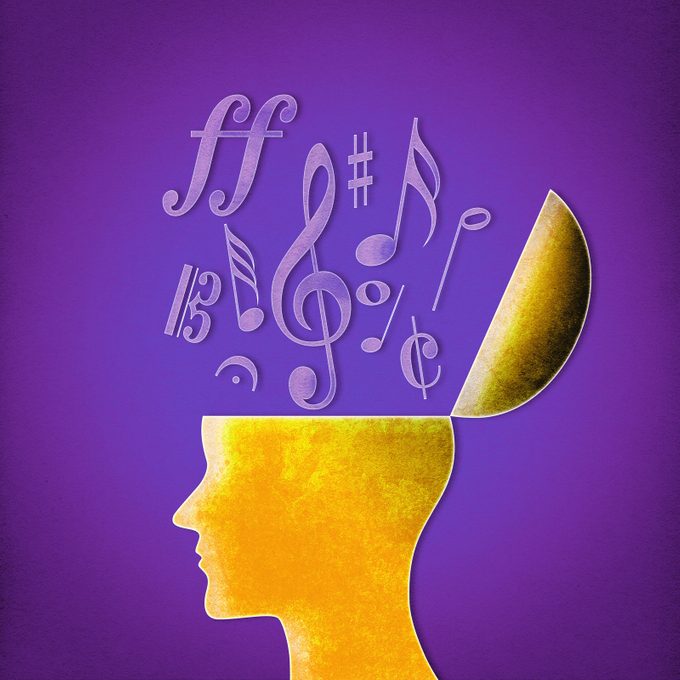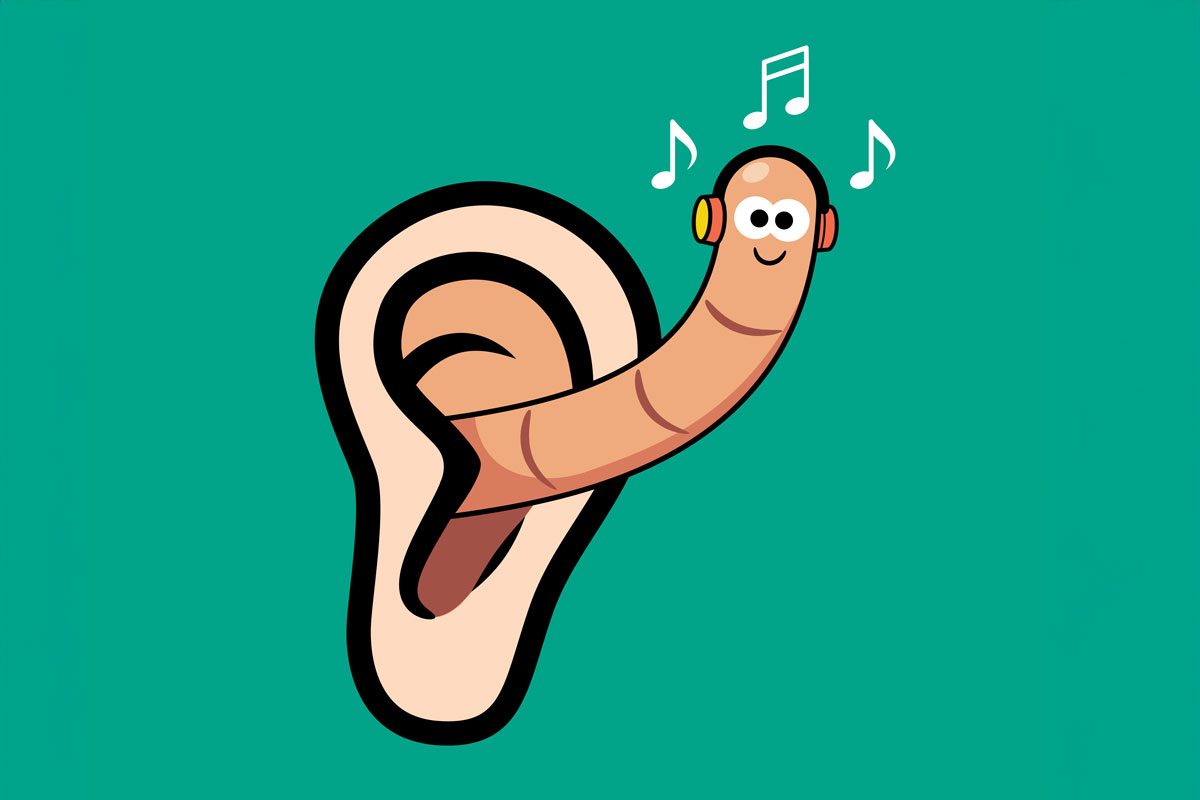We've all had a tune linger in our heads for much longer than we'd like. Here's what, exactly, earworms are—and what you can do to get rid of them.

What Is an Earworm? Here’s How to Get a Song Out of Your Head

As I write this, I have a Bob Seger song stuck in my head. I despised it when it came out decades ago, and I still hate it with a fiery passion. It popped up as the song playing over the closing credits of a movie I watched, and now it’s on a torturous permanent repeat in my brain. Why, oh why, do songs get stuck in our heads and what is an earworm from a scientific perspective?
We’ll get to that very soon, but first, a little history about them. According to the Kennedy Center for the Performing Arts in Washington, D.C., Germans coined the term öhrwurm—earworm—more than 100 years ago to describe the experience of a song stuck in the brain. It definitely wasn’t “Baby Shark” back then, but this problem clearly has been irritating people for a long, long time.
To help solve this musical mystery, I talked to music psychologists and scientists about one of the weird facts about the human body. Because even if it’s a funny song, that endless feeling of déjà vu can get really annoying. Read on to find out what an earworm is and—most important—how to get it out of your brain.
Get Reader’s Digest’s Read Up newsletter for more music, humor, cleaning, travel, tech and fun facts all week long.
What causes earworms?

Like the science of yawns, the phenomenon of earworms is truly fascinating. Earworms are a form of auditory imagery in which we perceive tone in the brain without actually hearing it. “The auditory cortex is located in the temporal lobe of the brain,” says Samata Sharma, MD, director of addiction consult psychiatry at Brigham and Women’s Hospital in Boston, who has carried out research on this topic.
Earworms—also known as involuntary musical imagery—penetrate both the regions of the cortex that perceive music and comprehend lyrics. “When a familiar song is heard and suddenly stopped, these areas of the brain become overly activated in anticipation of hearing the rest of the song, and then it fills in the missing pieces,” she says.
Earworms are triggered by catchy tunes with simple melodies and subtly surprising rhythms. “Then, even when it’s quiet and in the song’s absence, the auditory cortex may remain active long after the song ends and replays the song,” says Dr. Sharma. “Usually, the most memorable part of the song is the hook, and this is then the piece of the song that gets replayed over and over again.” This is why commercial jingles are such an effective sales strategy.
Who’s at risk for earworms?
Susceptibility to earworms isn’t some inherited trait, like your hair color. In fact, no one with hearing is immune to earworms, but according to the latest research by Kelly Jakubowski, there are a few personality characteristics that can make them happen more often.
“People who score higher in the personality trait of openness to experience report more frequent earworms,” says Jakubowski, an associate professor of music psychology at Durham University in England. In one large study, she points out, women reported more frequent earworms.
Another study found that people who are prone to stress, anxiety or even boredom may be more likely to get earworms. The general consensus is that the brain may fall back on well-known, internally stored stimuli, such as brief musical passages, when it is cognitively stressed or lacks external stimulation.
“It is entirely normal to experience earworms: Over 90% of participants in large-scale surveys report having had earworms at least once a week, and they are not a symptom of any other underlying mental condition,” says Jakubowski. “There have been some studies showing that people who are high in obsessive-compulsive traits report more frequent and disturbing earworms, and there are clinical cases of related experiences like musical obsessions and musical hallucinations, but these are on the whole much less common than everyday earworms.”
You may have seen a viral TikTok of a guy saying earworms aren’t normal but are instead symptoms of ADHD or OCD, which is generally not the case.
Are certain songs more likely to become earworms?
Absolutely, and Jakubowski conducted a large and detailed study on that. Her research on pop songs found that earworms are “more likely to be upbeat [faster-tempo] songs and are more likely to have relatively generic melodic contours, like nursery rhymes,” she says. Songs that make big or frequent leaps in the musical scale can also bore into your brain and stay there.
So which songs on your playlist are most likely to play on repeat in your head? According to Jakubowski’s findings, Lady Gaga’s “Bad Romance” tops the list. Other tunes with longevity included “Don’t Stop Believing” by Journey and, fittingly, “Can’t Get You Out of My Head” by Kylie Minogue.
Notably, media and technology trends have greatly increased the reach of certain songs. The emergence of social media video platforms like TikTok and Instagram Reels has fundamentally changed the way songs not only go viral but also stick in our minds. On any given day, we’re bombarded with the same catchy song playing on repeat as we scroll—and we hear just enough to activate our brains and keep us anticipating more.
Are there any upsides to earworms?
In fact, there are. Dr. Sharma says a recent study found that if a certain song is associated with a specific event in time and then replayed one to four weeks after the event, those who go on to experience earworms have better recall of the details of the event. “So in a certain sense, that repetitive loop of the song being played over and over again in your head may be strengthening your ability to remember a past event in greater detail,” she says.
How can you stop an earworm?
So back to my pressing dilemma: How do I get “You’ll Accomp’ny Me” out of my head? Aside from its relentlessly repetitive hook (with terrible lyrics), this love song doesn’t really fit the bill of the poppy songs that most often burrow into our brains. (Trust me, I would have preferred to have one of those on auto-repeat instead.)
Sadly, neither of the experts interviewed for this story had a long list of solutions to this problem. But here’s what they do know—and what I’ve discovered as I desperately try to get this earworm out of my mind.
Listen to the entire song

One way to get an earworm out of your head is to listen to the entire song from start to finish. “It can help your brain resolve the unfinished loop that’s causing the song to stick in your head,” says Jakubowski.
In my case, that solution was a hard no. I couldn’t bear the thought of listening to the whole lousy song again. But Jakubowski said that a study conducted by some of her colleagues found that listening all the way through a song can give you closure.
Distract yourself with another tune
That same research found that distracting yourself with another melody works too. So pick one of these happy songs and drive that earworm out of your head.
Intrigued by the list of popular earworms, I decided I’d much rather have Kylie lodged in my brain. I played her catchy dance hit on Spotify, and it actually got stuck in my brain for a while. What a refreshing change of pace! But a day or two later, Bob Seger was back, belting out his early 20th-century fantasy about accompanying a woman to a barn dance.
Engage your mind in activities that require focus
A conversation or a mental activity can shift your focus from the song playing in your head. For days, I tried to put my earworm on pause and turn my thoughts to something else. It didn’t help for more than an hour or two.
But you can also try solving puzzles or working math problems—if that’s your thing. Engaging your brain in a different way might help push out the repeated song. But I can personally testify that writing an article about earworms does not help.
Chew gum
This tip has some bona fide science behind it. Chewing gum or eating something crunchy can engage your auditory senses and interrupt the song playing in your head.
“One experiment indeed found that chewing gum vigorously reduced the number of earworms the research participants experienced,” says Jakubowski. She said a few people still had them after trying that trick. I’m a mint person, so I didn’t have a pack of gum around to experiment with. Maybe “You’ll Accomp’ny Me” will accompany me to the convenience store?
Just accept it
Sometimes, trying too hard to get rid of a song can make it lodge even deeper. You may need to just deal with the fact that the song is there for this moment in time—even if you’ve hated it for decades—and it will eventually fade away. I’ve never once been accused of being a patient person, but I guess it’s finally time to start getting better at that.
So what worked for me?
The loathed movie-soundtrack song did finally leave my head, but it took about two weeks. I started to listen to a lot of playlists, and it’s now been replaced with “Too Late for Love” by Def Leppard. I have no idea why my brain latched onto that classic-rock tune, but at least I loved that song as a kid. Is it an improvement? Many would say definitely not. But for me, it’s a better earworm on day two of the loop. Just don’t hold me to that if it goes on for much longer.
About the experts
|
Why trust us
At Reader’s Digest, we’re committed to producing high-quality content by writers with expertise and experience in their field in consultation with relevant, qualified experts. We rely on reputable primary sources, including government and professional organizations and academic institutions as well as our writers’ personal experiences where appropriate. We verify all facts and data, back them with credible sourcing and revisit them over time to ensure they remain accurate and up to date. For this piece on what an earworm is, Cathy Garrard tapped her experience as a journalist who has covered topics including psychology and health science for 30 years. Read more about our team, our contributors and our editorial policies.
Sources:
- Psychology of Aesthetics, Creativity and the Arts: “Dissecting an earworm: Melodic features and song popularity predict involuntary musical imagery”
- Crossroads of Music and Medicine: “Setting the Stage: Neurobiological Effects of Music on the Brain”
- American Psychological Association: “Psychologists Identify Key Characteristics of Earworms”
- Kelly Jakubowski, PhD, associate professor of music psychology and co-director of the Centre for Research into Inner Experience in the Department of Music at Durham University in England
- Samata Sharma, MD, director of addiction consult psychiatry at Brigham and Women’s Hospital in Boston






















